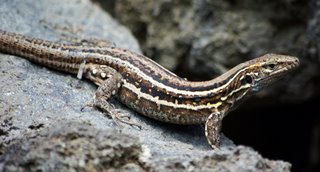Giant Lizards

Photo EFE
Yesterday I clean forgot that in December last year they found out that the giant Canarian lizard, Gallotia auaritae, isn't extinct after all. José Antonio Mateo, a reptile expert, only found the one, but he believes there must be a colony within a kilometre of the one he found. In this case, "giant" means 30 cm (one foot) long. Extinct specimens are larger.
Twenty-five years ago, they thought Gallotia lizards only survived on Gran Canaria (Gallotia stehlini). Since then, species have been found on several other islands. The ones on La Gomera (Gallotia bravoana) and El Hierro (Gallotia simonyi) grow to a whacking 60 cm long, while the one on Tenerife (Gallotia galloti) grows to 40cm long.
Like so many animals these days, the whole lot are on the endangered list, except for the one on Gran Canaria.
I'd love to go looking for one, but they haven't told the public the location, probably very deliberately. After all, hundreds of tourists trampling all over their habitat probably would send them extinct.
Labels: animals, Canaries, Canary Island fauna, Canary islands, La Palma, Reptiles, Wildlife
Bookmark with:
 Del.icio.us Del.icio.us
|
 Digg Digg
|
 Reddit Reddit
|
 Facebook Facebook
|
 Furl It Furl It
|
 Newsvine Newsvine
|
|








